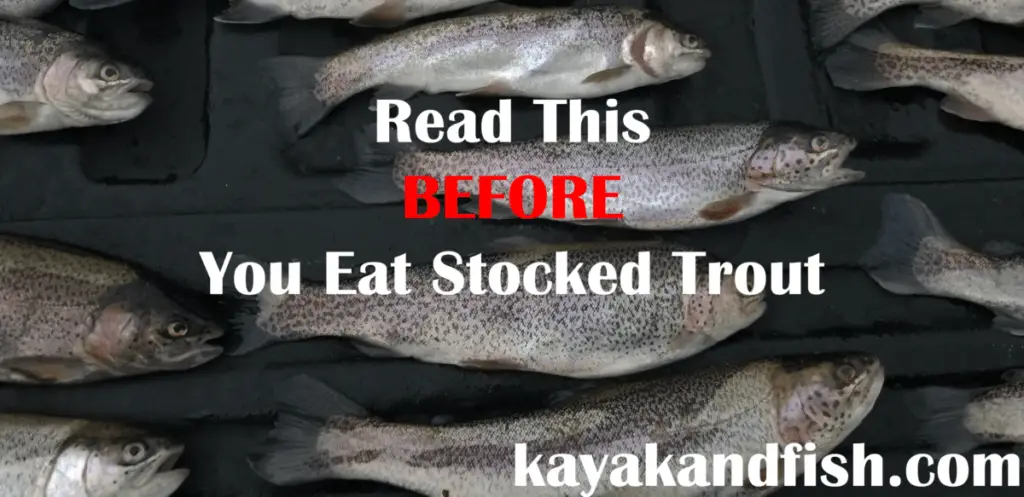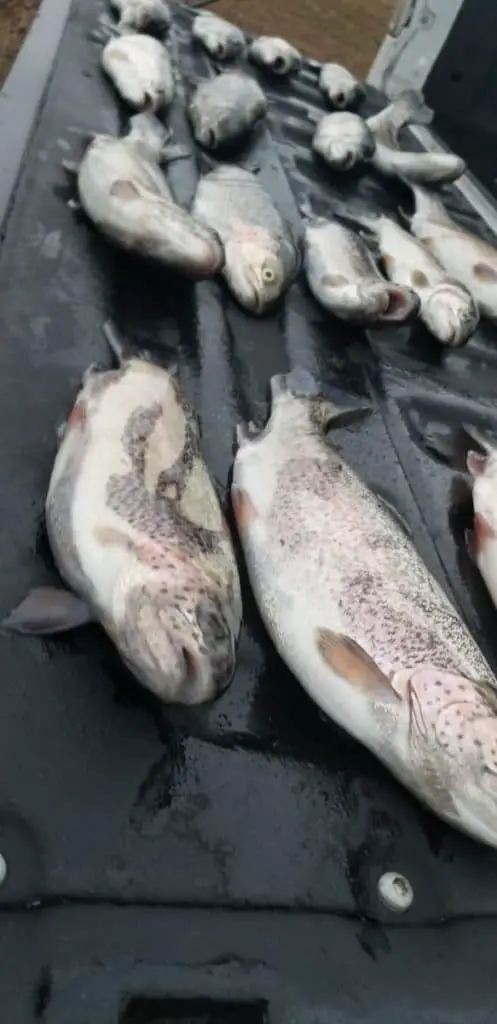
I look forward to the frigid late winter in West Virginia for one reason, trout stocking. Where I’m from, there are very few native trout and the ones we do have are super small. When it comes to catching and cooking stocked trout, there are some things you should know and keep in mind. So let’s dive into it.
Are stocked trout safe to eat? Yes, stocked trout are as safe to eat as any fish that you pull from the same body of water. There are some special precautions to take to ensure that you cook the trout correctly. You should also be conscious of the water quality of where you are fishing.
Why Would Trout Be Unsafe to Eat?
Unfortunately, in today’s world, we see a lot of pollution. Chemicals introduced into a pond aren’t seen by the naked human eye and you cannot tell if a fish is safe to eat or not just by looking at it 99% of the time. Thanks to the EPA, the waters are getting cleaner all the time!
Stocked trout are raised in a controlled environment where the water is very well regulated by the Department of Natural Resources. To be clear, I am talking about the trout that are stocked in ponds and streams by the DNR themselves.
If you’re interested in the process that the DNR follows to grow these amazing game fish, there is a video showcasing the entire trout raising process at the Tonto Creek Hatchery in Arizona.
A very interesting look at how these fish are raised and can provide some quality assurance, for sure.
Since the trout are so well taken care of in a controlled environment, they are safe to eat. The streams and ponds that they stock with these trout should be generally safe as well but even if they aren’t, the trout haven’t lived and fed in the water for long enough to become affected.
About Private Trout Farms…
There are some private trout farms located around the country, some states are more commonplace for them than others. These private farms are known for stocking large trout that are generally easy to catch. They normally own a small man-made pond that you pay to fish in.
You pay one of two ways: by the fish or an entry fee to catch your daily limit. As you may come to expect from a private company, there may be shady happenings and the fish may not be as well maintained or as healthy as they should be.
Now, don’t let this discourage you from visiting a private trout farm as they can experience for those who want to catch large trout fast, opposed to sitting on the bank of a large pond all day, or a great place to take young children.
Private trout farms are like privately owned restaurants in the sense that they can either be very well maintained or run very questionably. The best course of action would be reading Google reviews and asking your friends about the trout farm before you go.

Handle Trout Properly to Ensure Quality and Great Taste
The majority of trout fishermen reel in their catch, remove the hook, thread a stringer through its gills, and toss it back into the water. The issue here is that the angler leaves the fish alive to experience a slow death.
I argue that this affects the final taste of the meat and I have evidence to support this claim. This article written by Science Mag states that they believe fish that sie slowly taste worse because of a high concentration of hydroperoxide, which accumulates in the body during stress. This build-up leads the meat to become rancid quicker but also affects the immediate taste and smell of the meat.
Dispatching of a trout quickly isn’t required but it is suggested. It keeps the meat tasting and smelling better while remaining fresh for longer. Not to mention that it is more humane than smothering it on a stringer.
When I am fishing for something that I want to eat, I carry the trusty fish bat that I got on Amazon. This thing is exactly as it sounds, it is a short bat that you can use to deliver a precise strike to the head of your catch to dispatch of it quickly and humanely.
After you dispatch of the trout, you can choose to gut it there or place him immediately on ice and do it when you get home.
Time to Freeze The Trout, or is it?
The logical thing to do after skinning and gutting your trout is to prepare to freeze it right? Not necessarily. The taste of well prepared fresh trout can not be beat so set a few pieces aside to be cooked today or within the next 2 days. Later in this post, I will go over my absolute favorite recipe for trout.
You have to freeze the fish to preserve it long-term but you should understand a few myths about freezing first.
- Freezing does not change the nutritional value of the fish
- The bacteria that causes decay is still present when frozen but frozen
- When you freeze fish, sharp ice crystals form inside of the meat which cause the fibers to break down, which will affect taste when thawed.
- Natural flavors escape during the thawing of the fish.
So now that we have decided to set some fish aside for cooking within the next 36 hours, we can freeze the rest. Let’s go over some proper freezing and thawing techniques.

How to Properly Freeze and Thaw Your Trout
Freezer burn is a terrible way to waste meat because it is ENTIRELY preventable, you read that correctly. Growing up, I accepted freezer burn as something that naturally occurred over a period of time, but that isn’t true because you can prevent it.
I would like to point out that freezer burnt trout can still be safe to eat as long as you trim away discolored parts of the meat while preparing it. Freezer burn will just make your meat taste bland and extremely dry.
The best way to prevent freezer burn on your newly caught trout is to vacuum seal your meat before storage. Any professional meat processing business will always vacuum seal your meat for you but you can do it at home easily and relatively inexpensive.
When I bought my vacuum sealer, I knew nothing about them so I just went to Amazon and bought the highest rated one with a reasonable price. I ended up with this Vacuum Sealer by Nutrichef (Amazon) and it has worked flawlessly. I use it package all of my meat now.
When thawing your fish it is best to let it thaw naturally in the fridge for a few days instead of letting it sit at room temperature or thawing it in the microwave (this can begin to cook the meat if you are not careful). You can also thaw the meat by submerging it in cold water for a long period of time.
My Secret Recipe
I’m going to let you in on my absolute favorite way to cook trout, my secret recipe. I guess I can no longer call it my secret recipe after I share this article but that’s okay because the recipe is so good that it deserves to be shared.
- Begin by taking 2 trout fillets and seasoning them generously with Italian herb and salt. Season both sides unless you are using fillets with skin.
- Heat up a frying pan on the stove with enough butter to coat the cooking surface. Set the stove to low heat so that you can cook the trout slowly.
- Place the trout into the pan and cook for about 5 minutes on each side. You can add a little more butter if you need to.
- Sprinkle some garlic powder and basil onto the trout and flip again if necessary.
- After a few minutes, remove the fillets from the pan and sprinkle some parsley on them and add a lemon slice. Squeeze the lemon slice over the fish to add juice to it.
- Serve and enjoy!
And there you have it, simple and tasty just like I like it. Now I’m no chef but I think it tastes pretty good. Enjoy.

